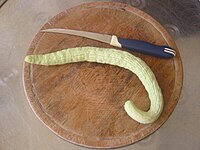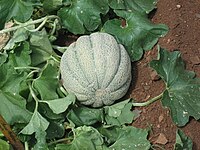
A new potential variety of cultivated melon (Cucumis melo L.) from north western India
Sign Up to like & getrecommendations! Published in 2020 at "Genetic Resources and Crop Evolution"
DOI: 10.1007/s10722-020-00997-2
Abstract: A new potential variety of melon ( Cucumis melo L.; family Cucurbitaceae) is described here from Rajasthan, North western India. Detailed description, illustration and photo plate are provided to facilitate identification of this new variety. read more here.
Keywords: cucumis melo; potential variety; variety; new potential ... See more keywords

Molecular and morphological characterisation of the oldest Cucumis melo L. seeds found in the Western Mediterranean Basin
Sign Up to like & getrecommendations! Published in 2017 at "Archaeological and Anthropological Sciences"
DOI: 10.1007/s12520-017-0560-z
Abstract: In 2008–2009, a rescue excavation uncovered an intact Late Bronze Age well in Sa Osa, Sardinia (Italy). The structure yielded a large number of waterlogged plant remains, of which a group of melon seeds (Cucumis… read more here.
Keywords: western mediterranean; molecular morphological; cucumis melo; morphological characterisation ... See more keywords

Identification of Fusarium wilt resistance sources in melon (Cucumis melo L.) landraces of Iran using marker-assisted selection technique
Sign Up to like & getrecommendations! Published in 2020 at "Australasian Plant Pathology"
DOI: 10.1007/s13313-020-00713-9
Abstract: Melon (Cucumis melo L.) is an important popular high-consumption product in the world. Melon Fusarium wilt (Fusarium oxysporum f.sp. melonis: FOM) is a global destructive disease. In this research, 88 melon landraces from different geographical… read more here.
Keywords: fusarium; disease; resistance; cucumis melo ... See more keywords

Draft genome sequences of two oriental melons, Cucumis melo L. var. makuwa
Sign Up to like & getrecommendations! Published in 2019 at "Scientific Data"
DOI: 10.1038/s41597-019-0244-x
Abstract: AbstractOriental melon (Cucumis melo L. var. makuwa) is one of the most important cultivated cucurbits, and is grown widely in Northeast Asian countries. With increasing interest in its biological properties and economic importance, oriental melon… read more here.
Keywords: melo; genome sequences; var makuwa; melo var ... See more keywords

Genome-Wide Linkage-Disequilibrium Mapping to the Candidate Gene Level in Melon (Cucumis melo)
Sign Up to like & getrecommendations! Published in 2017 at "Scientific Reports"
DOI: 10.1038/s41598-017-09987-4
Abstract: Cucumis melo is highly diverse for fruit traits providing wide breeding and genetic research opportunities, including genome-wide association (GWA) analysis. We used a collection of 177 accessions representing the two C. melo subspecies and 11… read more here.
Keywords: genome wide; gene level; melon; cucumis melo ... See more keywords

The anti-inflammatory, anti-ulcer activities and phytochemical investigation of Cucumis melo L. cv. Ismailawi fruits.
Sign Up to like & getrecommendations! Published in 2020 at "Natural product research"
DOI: 10.1080/14786419.2020.1803314
Abstract: This study aims to evaluate the anti-inflammatory and anti-ulcer activities of Cucumis melo L. cv. Ismailawi fruits, as well as the investigation of the phenolic content and lipoidal matter composition via high performance liquid chromatography… read more here.
Keywords: ismailawi fruits; investigation; anti ulcer; cucumis melo ... See more keywords

Mapping Resistance to Alternaria cucumerina in Cucumis melo.
Sign Up to like & getrecommendations! Published in 2017 at "Phytopathology"
DOI: 10.1094/phyto-06-16-0246-r
Abstract: Infection with Alternaria cucumerina causes Alternaria leaf blight (ALB), a disease characterized by lesion formation on leaves, leading to substantial yield and quality losses in Cucumis melo (melon). Although fungicides are effective against ALB, reduction… read more here.
Keywords: resistance alternaria; mapping resistance; resistance; cucumis melo ... See more keywords

Comparative transcriptomic analysis of two Cucumis melo var. saccharinus germplasms differing in fruit physical and chemical characteristics
Sign Up to like & getrecommendations! Published in 2022 at "BMC Plant Biology"
DOI: 10.1186/s12870-022-03550-8
Abstract: Background Hami melon ( Cucumis melo var. saccharinus ) is a popular fruit in China because of its excellent taste, which is largely determined by its physicochemical characteristics, including flesh texture, sugar content, aroma, and… read more here.
Keywords: cucumis melo; var saccharinus; fruit; development ... See more keywords

Fosthiazate inhibits root-knot disease and alters rhizosphere microbiome of Cucumis melo var. saccharinus
Sign Up to like & getrecommendations! Published in 2023 at "Frontiers in Microbiology"
DOI: 10.3389/fmicb.2022.1084010
Abstract: Root-knot nematodes especially Meloidogyne spp. are considered as most destructive obligate parasites that substantially reduce crop yield and quality. Fosthiazate is an efficient organothiophosphate chemical with nematicidal activity against Meloidogyne spp. The present study aimed… read more here.
Keywords: cucumis melo; root knot; knot disease; var saccharinus ... See more keywords

Cucumis melo L. Germplasm in Tunisia: Unexploited Sources of Resistance to Fusarium Wilt
Sign Up to like & getrecommendations! Published in 2021 at "Horticulturae"
DOI: 10.3390/horticulturae7080208
Abstract: Breeding for disease resistance has been one of the most important research objectives in melon for the last few decades. Fusarium wilt caused by Fusarium oxysporum f. sp. melonis (Fom) is among the most threatening… read more here.
Keywords: cucumis melo; sources resistance; fusarium wilt; resistance ... See more keywords

Comparative Metabolomics and Molecular Phylogenetics of Melon (Cucumis melo, Cucurbitaceae) Biodiversity
Sign Up to like & getrecommendations! Published in 2020 at "Metabolites"
DOI: 10.3390/metabo10030121
Abstract: The broad variability of Cucumis melo (melon, Cucurbitaceae) presents a challenge to conventional classification and organization within the species. To shed further light on the infraspecific relationships within C. melo, we compared genotypic and metabolomic… read more here.
Keywords: melo; molecular phylogenetics; comparative metabolomics; cucumis melo ... See more keywords